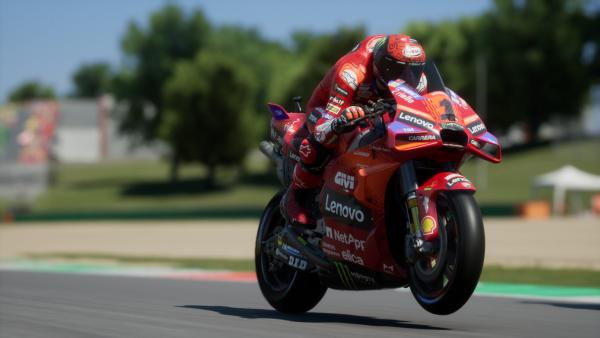
2024 marks 11 years since Milestone began developing the MotoGP games, so how does its latest entry, MotoGP 24, fair?
MotoGP 24 marks the 12th entry in the series since Milestone took over development for the 2013 title. Since then, it’s gone through three game engines (currently Unreal Engine 4 since 2018), has added features only to remove them only to bring them back again, and even had one title (2016’s) dedicated to Valentino Rossi and including alternate disciplines like drifting, rallying (sort of), and flat track. So how does this one get on?
In the interests of disclosure, I haven’t, to quote Jay from The Inbetweeners, ‘completed it, mate’. I have, however, sunk four hours into the game, almost all in the time trial mode. I wish I could say that this was because the game felt so good that I couldn’t bear to exit to the main menu, but that’s not entirely true.
Having not played much of the MotoGP series since 2019, but nonetheless watching each release with some intrigue, I was expecting some complications in braking. And there were, just not the kind I was expecting. In the 2020-2023 MotoGP games, braking was made more difficult by the rear of the bike lifting during braking, which meant the player couldn’t just mash the brake but rather had to feather it to keep the rear tyre on the floor.
It’s sort of the same in MotoGP 24, in that you can’t brake as hard as possible, but now it’s because the game doesn’t let the bike lean into the corner if too much brake pressure is applied. It’s a strange feeling, in fact at first it was infuriating, because it feels like an add-on to the physics, like it’s not really supposed to be there, and you can’t really feel where the limit of that intervention is and so it takes some getting used to.
But I did start to get used to it towards the end of those four hours, partly by making the bike as stiff and as tall as possible in the setup menu to make it more agile, and partly by understanding how to play the game with the physics how they are. It must be said that to be able to adapt to how the game works in only a handful of hours seems like a sign that the game is pretty easy and straightforward to pick up.
As I got used to the physics, did it start to feel enjoyable? Sort of, but I feel like there’s not a huge amount going on in the middle of the corner, which I think is where the game feels the weakest. When you release the brake and open the throttle, you don’t feel any weight balance change in the bike - it just keeps turning as it already was, you only hear the engine note change.
The braking, when you nail it, though, does feel pretty good and even quite satisfying, and there’s a nice opportunity to slide a bit on corner exit (for example, turn three at Barcelona) which is quite nice and hasn’t always been the case with Milestone’s asphalt motorcycle racing games.
Additionally, MotoGP 24 is the first MotoGP game I’ve played with the ride height device functionality. Thankfully, these are banned in MotoGP from 2027, but I like how they’re implemented in MotoGP 24. It’s not just a simple ‘go fast’ button - you have to consider where you can use it, because once it’s activated you can’t turn really at all, and you can’t deactivate it until you brake.
So, for example, turn four exit at Le Mans, you can’t use it even though you’re coming from a second-gear corner and going over a crest, and therefore need to control the wheelie, because you have to turn through turn five. Or, exit of De Strubben at Assen you can’t use it, because you need to turn into the Ruskenhoek section at the end of the Veenslang before you brake. I like that consideration, and I also like that using the RHD doesn’t automatically kill your wheelie - you still need to use the rear brake a bit.
It also changes how you ride, because if you want to activate it you want to do it as soon as possible, so you want to stand the bike up as early as possible to get it to activate, which means you find yourself squaring the exits off much more. For me, it’s fascinating how this one thing really changes how you play, and also how you approach a corner.
Corner exit also feels better for the sound, which is particularly aggressive and quite loud. Somehow, the sound adds to the sense of speed, and in general it feels pretty accurate (apart from the KTM, which still has the sound from the first four races of 2017).
Apart from the bikes, the most important thing about a racing game is the tracks. They’re all there in MotoGP 24 - all the official 2024 tracks, plus historic tracks: Laguna Seca, Donington Park, Indianapolis, Estoril, and Termas de Rio Hondo. But I’m not sure I find any of them hugely enjoyable. All of the corners just feel somehow the same, and the sense of speed that is there in the straights is somehow missing in the corners, even in sections like Biondetti at Mugello or Abbey-Farm at Silverstone.
In general, if I had to say briefly how I found playing MotoGP 24 from a physics point of view, I would simply say that after four hours I felt like I’d have rather played Ride 4.
The AI hasn’t been hugely inspiring for me to play more MotoGP 24, either. Somehow in Milestone’s games it always feels like the AI can do things the player can’t, whether it’s turning tighter with more speed in MotoGP or jumping forwards in mid-air in Supercross.
There is also the new Adaptive AI feature in MotoGP 24. To give you an idea of how this works, I ran two, seven-lap races at Le Mans. The first had Adaptive AI enabled, and I (playing as Pecco Bagnaia) went from last to first in almost precisely seven laps. The second had Adaptive AI disabled and the AI difficulty set to 120 per cent, and in this race I (Bagnaia, again) went from last-to-14th in one lap, and then was a roadblock to everyone 15th-back for the remaining six laps (which doesn’t exactly suggest much positive about the AI’s overtaking abilities), and I finished 20 seconds behind Enea Bastianini who won. The Adaptive stuff isn’t very subtle, either - with it enabled the AI was just shutting the throttle in the middle of the pit straight, for example. I did notice on the second race, though, that the AI seemed more aggressive on the final lap - Raul Fernandez dive-bombed me in Le Mans’ super-fast turn two, for example.
I had more fun in time trial, I think, but maybe that’s because I still felt like I was progressing and in time trial I could focus on that, whereas in the race the AI was either letting me win or lapping 2.5 seconds faster. Still, I remember playing MotoGP 15 and lapping four seconds per lap faster than the AI on the hardest setting and without really trying, so it's at least good to feel like I have to improve.
The MotoGP Stewards feature is new this year. It penalises the AI in addition to the player, but is way too strict on its harshest setting (there are two: Strict and Tolerant) to be enjoyable in a game where contact with other bikes is almost guaranteed because of how heavy and cumbersome the bikes are in combination with the somewhat odd way the AI races. On the more lenient ‘Tolerant’ setting, you have to cut the inside of a corner before you get a track limits warning. I feel like I want to turn the feature off and have the same penalty system as before, but you can’t turn it off.
The Career Mode is very odd now because it forces you to start in Moto3 after years of being able to choose in which category you want to start. You only do two Moto3 races and then move on, which was still too much Moto3 for me to want to try it - I don’t think there’s been a single MotoGP game where Moto3 has felt ‘good’ to me, and this is another.
If you do try Career Mode, though, there is the new rider market feature that is waiting for you. Riders can now move up and down classes, and from team to team which should help it stay a little fresher. Time will tell on that one, but nonetheless, this is a long-awaited feature in the series and it’s good to see it finally appear.
One final thing you will notice if you pick the game up right now is that the Moto3 and Moto2 liveries are still the 2023 liveries. That means that the MT Helmets MSI team doesn’t have a livery in Moto2, and the Pierer Mobility Group Moto2 teams are still on Ohlins suspension, which admittedly is still only an aesthetic thing.
More frustratingly, the MotoGP bikes are still their 2023 models with 2024 liveries. For example, the Ducati still has its pre-Austria-2023 downwash ducts, the KTM still has its trapezoid rear wing, the Yamaha has its rooted-in-2018 front wing, the Honda still has its own pathetic 2023 aero, and the Aprilia is minus the new top element of its front wing. You have to wonder where are the merits of launching a game for a new season when almost everything in the game is still based on the previous year.
In summary, MotoGP 24 has some redeeming qualities, such as its implementation of ride height devices, but they ultimately battle against flaws which feel like they’ve been tacked onto the physics, an annoying stewarding system (as immersive as that is), impotent AI, and what seems to be a hasty release date.
Image credit: Milestone.

